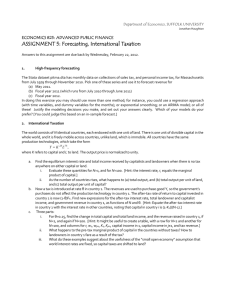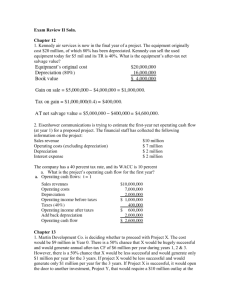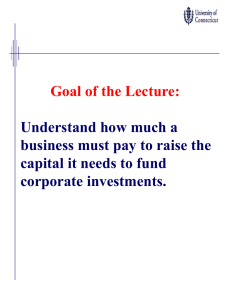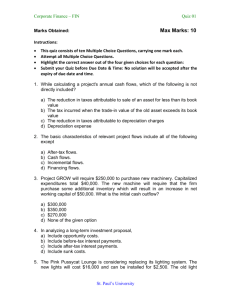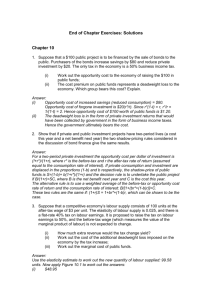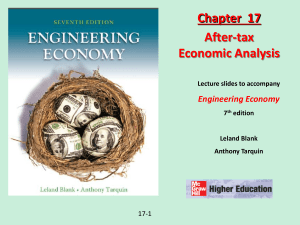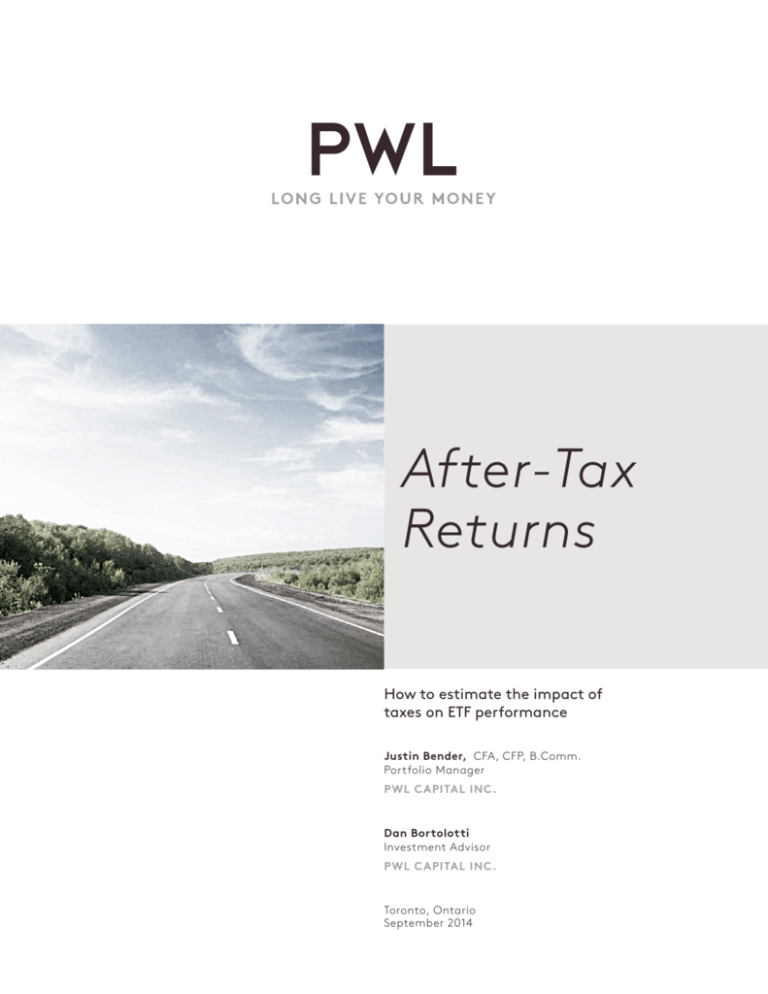
After-Tax
Returns
How to estimate the impact of
taxes on ETF performance
Justin Bender, CFA, CFP, B.Comm.
Portfolio Manager
PWL CAPITAL INC.
Dan Bortolotti
Investment Advisor
PWL CAPITAL INC.
Toronto, Ontario
September 2014
This report was written by Justin Bender, PWL Capital Inc. and Dan Bortolotti, PWL Capital Inc. The
ideas, opinions, and recommendations contained in this document are those of the authors and do
not necessarily represent the views of PWL Capital Inc.
The authors would like to thank Brad Steiman of Dimensional Fund Advisors for his helpful comments
on earlier drafts of this paper.
© PWL Capital Inc.
All rights reserved. No part of this publication may be reproduced without prior written approval of
the author and/or PWL Capital. PWL Capital would appreciate receiving a copy of any publication or
material that uses this document as a source. Please cite this document as:
Justin Bender, Portfolio Manager, PWL Capital Inc. and Dan Bortolotti, Investment Advisor, PWL
Capital Inc. “After-Tax Returns: How to estimate the impact of taxes on ETF performance”
For more information about this or other publications from PWL Capital, contact:
3 Church Street., Suite 601,Toronto, Ontario M5E 1M2
Tel
416 203-0067 • 1-866 242-0203 Fax 416 203-0544
capital@pwlcapital.com
This document is published by PWL Capital Inc. for your information only. Information on which this document is based is available on request. Particular investments
or trading strategies should be evaluated relative to each individual’s objectives, in consultation with the Investment Advisor. Opinions of PWL Capital constitute its
judgment as of the date of this publication, are subject to change without notice and are provided in good faith but without responsibility for any errors or omissions
contained herein. This document is supplied on the basis and understanding that neither PWL Capital Inc. nor its employees, agents or information suppliers is to be
under any responsibility of liability whatsoever in respect thereof.
If you hold your ETF investments outside registered accounts, taxes can take a big bite out of your returns. Unfortunately,
comparing the tax-efficiency of similar ETFs is difficult, because there is no standard method for estimating after-tax returns. In
Canada, fund returns are reported on a pre-tax basis, but this can be misleading. As we will see, two funds with similar pre-tax
returns can perform very differently when you account for the tax investors would pay on the distributions.
The goal of this paper is to emphasize the need for reliable after-tax return data so investors can make better decisions when
selecting ETFs for their portfolios.
Background
In 2001, the Securities and Exchange Commission made it mandatory for U.S. fund companies to supply after-tax return
calculations. This standardized reporting helped investors better understand the impact taxes have on the performance of their
mutual funds and ETFs. For example, here’s how the Vanguard Total Stock Market ETF (VTI) reports performance on its website:
Source: The Vanguard Group
Two years later, Amin Mawani, Moshe Milevsky, and Kamphol Panyagometh published a paper in the Canadian Tax Journal
called The Impact of Personal Income Taxes on Returns and Rankings of Canadian Equity Mutual Funds. The authors calculated
the after-tax returns of 343 Canadian mutual funds with at least 10 years of performance data. They discovered that ranking
funds based on before-tax and after-tax return produced very different results. For example, the best-performing fund before
taxes dropped to 16th place when its after-tax return was compared to others. The authors also found that investors in the
highest marginal tax bracket lost about 1.35 percentage points per year to taxes on fund distributions.
More than a decade later, Canadian funds are still not required to publish after-tax returns. Morningstar Canada, a fund data
provider, does calculate after-tax returns for a number of mutual funds and ETFs, but only if the fund companies provide the
necessary data, and not all of them do.
Methodology
In this paper we share our methodology for calculating after-tax returns, which we have applied to several popular Canadian
ETFs. It will not satisfy all critics, but we believe it is a useful starting point, especially since there is no standardized methodology
required by Canadian securities regulators.
Our method for calculating the pre-liquidation after-tax return for an ETF is adapted from the Morningstar After-Tax Return
Methodology, which was designed for U.S. investors. We have made changes where we felt they were appropriate for Canadian
investors.
After-Tax Returns
3
Pre- and Post-Liquidation After-Tax Returns
A pre-liquidation after-tax return accounts for taxes paid on distributions before the after-tax proceeds are reinvested
in additional units. The investor has little control over these distributions, as they are the result of the fund manager’s
selections and trading.
A post-liquidation after-tax return includes the capital gain or loss realized when investors actually sell their shares.
Because investors can usually choose when to sell their shares, post-liquidation after-tax returns will vary greatly among
individuals.
Throughout this paper we have limited the discussion to pre-liquidation after-tax returns.
To make our calculations, we created a spreadsheet that allowed us to input the date, amount and character of each distribution
paid by the ETF. We also entered the net asset value (NAV) per share on the ex-dividend date of each distribution. The
spreadsheet then calculated the before-tax return (both reported and adjusted, as explained below), after-tax return, and tax
cost ratio for the ETF over periods of one to 10 years.
We have made our PWL 2013 After-Tax Rate of Return Calculator for Canadian ETFs available for download. The
spreadsheet is protected so the formulas cannot be altered. However, we have included detailed descriptions of these formulas
in the appendix.
How to use the spreadsheet
To help you understand and use our downloadable spreadsheet, we’ll work through a calculation using the iShares Core S&P/
TSX Composite High Dividend Index ETF (XEI).
1. Note the ex-dividend date of each distribution.
Start by visiting the ETF’s web page and clicking the “Distributions” tab to view the dates and amounts of each distribution.
Record the ex-dividend date for each distribution in 2013, as you will need to enter these into the spreadsheet.
2013 EX-DIVIDEND DATES: XEI
Source: BlackRock Canada
4
After-Tax Returns
The spreadsheet assumes all distributions are reinvested on the ex-dividend date. In reality an investor would not be able to
reinvest the distributions until the payment date; however, most before-tax performance calculations assume dividends are
reinvested on the ex-dividend date, so this allows our before and after-tax comparisons to remain consistent.
Also, payment dates may fall in the month following the ex-dividend date, which can lead to confusion when calculating the
after-tax rate of return over a specific period using our spreadsheet. For instance, as you can see in the above table, many
iShares ETFs had year-end distributions in 2013 that were not paid until January 6, 2014.
2. Look up the ETF’s net asset value (NAV) per share on each ex-dividend date an
the last day of each year.
An ETF’s net asset value per share at the close of each trading day is available on the fund’s web page. These historical prices
can be downloaded as an Excel file. (After downloading the spreadsheet, click the “Historical” tab to view the correct worksheet.)
Source: BlackRock Canada
For each ex-dividend date you have collected, look up the historical price per share. Also collect each year-end NAV surrounding
the period you will be analyzing. In our example, we would need to collect 12 ex-dividend date NAVs from 2013 as well as two
year-end NAVs: one for December 30, 2012 and the other for December 31, 2013.
3. Collect all the distribution data for the ETF.
We created columns on our spreadsheet for each type of distribution an ETF might pay: Canadian dividends (eligible and noneligible), other income (including interest and income from real estate investment trusts), foreign income, return of capital and
capital gains. We also included columns for foreign tax paid (typically withholding tax on dividends) and reinvested distributions.
You can obtain this information from the CDS Innovations Tax Breakdown Posting service. For a complete description of this
service, see our earlier white paper: As Easy as ACB: Understanding and tracking your adjusted cost base with ETFs.
We recommend you print the Statement of Trust Income Allocations and Designations report for each tax year in order to
input the numbers into our spreadsheet.
After-Tax Returns
5
2013 STATEMENT OF TRUST INCOME ALLOCATIONS AND DESIGNATIONS: XEI
Sources: BlackRock Canada, CDS Innovations Inc.
Some of the distribution information in these reports is confusing. Please note the following:
•
The distinction between eligible (labeled EDVi on our spreadsheet) and non-eligible dividends (NDVi) did not exist until the
2006 tax year. Dividends received in prior years were characterized simply as Canadian dividends (CDVi).
•
Foreign income (FINi) is the gross amount of foreign dividends. It is a combination of the net amount distributed to investors
plus the final level of foreign withholding tax that is generally recoverable (see “The Impact of Foreign Withholding Taxes” in
the Appendices).
•
Foreign tax paid (FTPi) should be entered as a positive value in our spreadsheet.
•
On the spreadsheets available from CDS Innovations, reinvested distributions (RDSi) are normally labeled as Total Non Cash
Distribution per Unit ($), or mentioned in the Notes section of the Statement of Income Allocations and Designations
report.
•
Some ETF providers, such as BMO Financial Group, use percentages rather than dollar figures when itemizing distributions
in their CDS reports. You will need to convert these to a dollar figure before entering them into our spreadsheet.
4. Enter all the data into the spreadsheet
Once you have gathered the ex-dividend dates, historical prices and distribution details for the 2013 tax year, you should have
all the information you need to calculate the ETF’s one-year after-tax return.
Our spreadsheet is pre-filled with the name of each month in column A: simply enter the ex-dividend date in column B. (For ETFs
that pay distributions quarterly in March, June, September and December, just leave the other months blank.)
Then enter each cash distribution in the appropriate box. Be careful to include any reinvested distributions as well (they are
usually at year end).
6
After-Tax Returns
PWL 2013 AFTER-TAX RATE OF RETURN CALCULATOR: XEI
Sources: PWL Capital Inc., BlackRock Canada, CDS Innovations Inc.
The spreadsheet will calculate the total annual distributions of each type. You may find it helpful to compare these totals to
the annual summary on the ETF’s website. If the totals don’t match, go back and make sure you haven’t mistyped something.
Source: BlackRock Canada
Understanding the Tax Cost Ratio
The simplest way to measure the tax-efficiency of an ETF is to divide the after-tax return by the before-tax return. This
will produce its “tax-efficiency ratio,” a number between 0 and 1 indicating the proportion of the before-tax return the
investor gets to keep.
For example, in 2013 the iShares U.S. High Yield Bond Index ETF (CAD-Hedged) (XHY) had an after-tax return of 3.74%
and a before-tax return of 6.85%, resulting in a tax-efficiency ratio of 0.546. This means the investor kept 54.6% of the
before-tax return and lost 45.4% to taxes.
Unfortunately, if the fund has a negative before-tax return, the tax-efficiency ratio would not make any sense. In 2013, for
example, the iShares Canadian Universe Bond Index ETF (XBB) had an after-tax return of -3.10% and a before tax return
of -1.47%, resulting in a tax-efficiency ratio of +2.11 or +211%, which is obviously incorrect.
After-Tax Returns
7
A different measure, the tax cost ratio, was popularized by Morningstar as a way to measure the proportion of a fund’s
annualized return that is lost to taxes on distributions. It produces a useful value whether the returns are positive or
negative. Where ATR is the after-tax return and BTR is the before-tax return, the equation for the tax cost ratio is
Tax Cost Ratio =1 - ( 1+ ATR )
( 1+ BTR )
A taxable investor who is comparing two similar funds that have the same before-tax return would prefer the fund with
the lower tax cost ratio.
Note, however, that the tax cost ratio can be distorted by differences in management fees and unrecoverable foreign
withholding taxes. For a full explanation, see the Appendices.
Comparing ETFs on an After-Tax Basis
Calculating after-tax returns allows you to compare two or more ETFs with similar before-tax returns and investment holdings.
Sometimes this produces surprising results.
In our sample calculation we saw that XEI had a before-tax return of 15.10% in 2013. The iShares Canadian Value Index ETF
(XCV) performed almost identically that year with a before tax-return of 15.07%. These two ETFs also have similar holdings.
Their after-tax returns, however, were significantly different: XCV had an after-tax return of 13.80% and a tax cost ratio of 1.10%.
XEI had an after-tax return of 12.73%, with a tax cost ratio of 2.06%. (This was largely due to the realization of significant capital
gains by XEI during 2013.)
To be fair, these are only one-year figures: a longer measurement period should be used for these types of comparisons.
PWL 2013 AFTER-TAX RATE OF RETURN CALCULATOR: XCV
Sources: PWL Capital Inc., BlackRock Canada, CDS Innovations Inc.
Comparing the tax cost ratio of funds in different asset classes can also help investors make better asset location decisions. For
example, the iShares Canadian Universe Bond Index ETF (XBB) had a 10-year tax cost ratio of 2.01%, nearly twice that of the
iShares Core S&P/TSX Capped Composite Index ETF (XIC), which came in at around 1.02%.
8
After-Tax Returns
In the tables below we’ve included the after-tax returns and tax cost ratios of ETFs in 13 different asset classes.
After-Tax Returns and Tax Cost Ratios:
All periods ending December 31, 2013
ISHARES CANADIAN SHORT TERM
BOND INDEX ETF (XSB)
Before-Tax Return
1-YEAR RETURN
3-YEAR
ANNUALIZED
RETURN
5-YEAR
ANNUALIZED
RETURN
10-YEAR
ANNUALIZED
RETURN
1.47%
2.54%
3.03%
3.95%
After-Tax Return
0.12%
1.06%
1.42%
2.07%
TAX COST RATIO
1.33%
1.44%
1.56%
1.81%
5-YEAR
ANNUALIZED
RETURN
10-YEAR
ANNUALIZED
RETURN
4.44%
4.94%
1-YEAR RETURN
3-YEAR
ANNUALIZED
RETURN
Before-Tax Return
-1.47%
3.62%
After-Tax Return
-3.10%
1.84%
2.51%
2.84%
TAX COST RATIO
1.66%
1.72%
1.84%
2.01%
5-YEAR
ANNUALIZED
RETURN
10-YEAR
ANNUALIZED
RETURN
ISHARES CANADIAN UNIVERSE
BOND INDEX ETF (XBB)
1-YEAR RETURN
3-YEAR
ANNUALIZED
RETURN
Before-Tax Return
-13.41%
1.50%
5.71%
-
After-Tax Return
-15.62%
-0.51%
3.88%
-
2.55%
1.98%
1.73%
-
1-YEAR RETURN
3-YEAR
ANNUALIZED
RETURN
5-YEAR
ANNUALIZED
RETURN
10-YEAR
ANNUALIZED
RETURN
ISHARES CANADIAN REAL RETURN
BOND INDEX ETF (XRB)
TAX COST RATIO
ISHARES U.S. HIGH YIELD BOND
INDEX ETF (CAD-HEDGED) (XHY)
Before-Tax Return
6.85%
8.21%
-
-
After-Tax Return
3.74%
4.70%
-
-
TAX COST RATIO
2.92%
3.25%
-
-
1-YEAR RETURN
3-YEAR
ANNUALIZED
RETURN
5-YEAR
ANNUALIZED
RETURN
10-YEAR
ANNUALIZED
RETURN
Before-Tax Return
-7.48%
-
-
-
After-Tax Return
-9.48%
-
-
-
2.15%
-
-
-
5-YEAR
ANNUALIZED
RETURN
10-YEAR
ANNUALIZED
RETURN
-
ISHARES J.P. MORGAN USD
EMERGING MARKETS BOND INDEX
ETF (CAD-HEDGED) (XEB)
TAX COST RATIO
1-YEAR RETURN
3-YEAR
ANNUALIZED
RETURN
Before-Tax Return
-3.03%
2.29%
7.57%
After-Tax Return
-4.48%
0.79%
6.05%
-
1.49%
1.47%
1.41%
-
ISHARES S&P/TSX CANADIAN
PREFERRED SHARE INDEX ETF (CPD)
TAX COST RATIO
After-Tax Returns
9
1-YEAR RETURN
3-YEAR
ANNUALIZED
RETURN
5-YEAR
ANNUALIZED
RETURN
10-YEAR
ANNUALIZED
RETURN
Before-Tax Return
18.96%
10.23%
15.63%
-
After-Tax Return
17.11%
8.31%
13.92%
-
TAX COST RATIO
1.55%
1.75%
1.48%
-
1-YEAR RETURN
3-YEAR
ANNUALIZED
RETURN
5-YEAR
ANNUALIZED
RETURN
10-YEAR
ANNUALIZED
RETURN
Before-Tax Return
-5.99%
9.72%
19.79%
9.61%
After-Tax Return
-8.56%
7.64%
17.84%
7.93%
2.72%
1.90%
1.63%
1.53%
5-YEAR
ANNUALIZED
RETURN
10-YEAR
ANNUALIZED
RETURN
11.13%
-
ISHARES CANADIAN SELECT
DIVIDEND INDEX ETF (XDV)
ISHARES S&P/TSX CAPPED REIT
INDEX ETF (XRE)
TAX COST RATIO
1-YEAR RETURN
3-YEAR
ANNUALIZED
RETURN
Before-Tax Return
8.29%
9.86%
After-Tax Return
7.03%
8.29%
9.29%
-
TAX COST RATIO
1.17%
1.42%
1.66%
-
1-YEAR RETURN
3-YEAR
ANNUALIZED
RETURN
5-YEAR
ANNUALIZED
RETURN
10-YEAR
ANNUALIZED
RETURN
ISHARES GLOBAL REAL ESTATE INDEX
ETF (CGR)
ISHARES CORE S&P/TSX CAPPED
COMPOSITE INDEX ETF (XIC)
Before-Tax Return
12.74%
3.14%
11.58%
7.93%
After-Tax Return
11.56%
2.22%
10.62%
6.82%
TAX COST RATIO
1.04%
0.89%
0.86%
1.02%
1-YEAR RETURN
3-YEAR
ANNUALIZED
RETURN
5-YEAR
ANNUALIZED
RETURN
10-YEAR
ANNUALIZED
RETURN
Before-Tax Return
32.91%
16.00%
16.98%
5.10%
After-Tax Return
31.74%
14.48%
15.50%
3.92%
TAX COST RATIO
0.88%
1.32%
1.26%
1.12%
5-YEAR
ANNUALIZED
RETURN
10-YEAR
ANNUALIZED
RETURN
3.87%
ISHARES CORE S&P 500 INDEX ETF
(CAD-HEDGED) (XSP)
1-YEAR RETURN
3-YEAR
ANNUALIZED
RETURN
Before-Tax Return
25.58%
9.33%
10.21%
After-Tax Return
23.94%
7.77%
8.70%
1.82%
1.31%
1.43%
1.37%
1.97%
1-YEAR RETURN
3-YEAR
ANNUALIZED
RETURN
5-YEAR
ANNUALIZED
RETURN
10-YEAR
ANNUALIZED
RETURN
Before-Tax Return
2.63%
-0.26%
-
-
After-Tax Return
1.56%
-1.18%
-
-
TAX COST RATIO
1.05%
0.92%
-
-
ISHARES MSCI EAFE INDEX ETF
(CAD-HEDGED) (XIN)
TAX COST RATIO
ISHARES MSCI EMERGING MARKETS
INDEX ETF (XEM)
10
After-Tax Returns
APPENDICES
Prices
In our after-tax return calculations, the price per share at is labeled as follows:
Pe
=
the price per share (NAV) at the end of the holding period
Pb
=
the price per share (NAV) at the beginning of the holding period
Pi
=
the price per share (NAV) on the ex-dividend date
Our formulas for after-tax distribution accounts for the different tax rates that apply to the various types of investment income.
We have labeled them as follows:
Investment Income
INCi
=
taxable interest income distributed on day i ($ per share): T3 Box No. 26
FINi
=
taxable foreign income distributed on day i ($ per share): T3 Box No. 25
CDVi
=
taxable Canadian dividends distributed on day i ($ per share): T3 Box No. 23 (pre-2006)
EDVi
=
taxable eligible dividends distributed on day i ($ per share): T3 Box No. 49 (post-2005)
NDVi
=
taxable non-eligible dividends distributed on day i ($ per share): T3 Box No. 23 (post-2005)
CAPi
=
capital gains distributed on day i ($ per share): T3 Box No. 21
ROCi
=
return of capital distributed on day i ($ per share): T3 Box No. 42
RDSi
=
reinvested distributions on day i ($ per share): Total non cash distribution per unit ($)
FTPi
=
foreign tax paid on distributions on day i ($ per share): T3 Box No. 34
Tax Rates
TXIi
=
the maximum combined federal / provincial income tax rate at time i
TXCi
=
the maximum combined federal / provincial Canadian dividend income tax rate at time i
TXEi
=
the maximum combined federal / provincial eligible dividend income tax rate at time i
TXNi
=
the maximum combined federal / provincial non eligible dividend income tax rate at time i
TXGi
=
the maximum combined federal / provincial capital gain tax rate at time i
Equations
After-Tax Distribution Per Share:
(
(
(
)
)
)
Pre-Liquidation After-Tax Return:
{
where
n
=
(
)
(
∏(
)
(
)
)}
number of distributions in the holding period
After-Tax Returns
11
Tax Assumptions
We have assumed our hypothetical investor is taxed at the maximum combined federal/provincial rate during each tax year. For
example, in 2004 residents of Newfoundland and Labrador paid the highest rate on all sources of investment income relative
to residents of other provinces or territories. However, in 2013 Nova Scotians paid the highest taxes on all income except noneligible dividends, where that honour went to residents of Manitoba.
It is unlikely any Canadian would pay the highest marginal tax rate on all sources of income in a year when these were split
between two or more provinces. But this method allows investors to view a worst-case scenario for after-tax returns and
compare it to their before-tax return. In practice, an investor’s returns will generally fall somewhere between these two values.
MAXIMUM COMBINED FEDERAL / PROVINCIAL INCOME TAX RATES: 2004–2013
2004
2005
2006
2007
2008
2009
2010
2011
2012
2013
Income
TAX RATES
48.64%
48.64%
48.64%
48.25%
48.25%
48.25%
48.25%
50.00%
50.00%
50.00%
Capital Gains
24.32%
24.32%
24.32%
24.13%
24.13%
24.13%
24.13%
25.00%
25.00%
25.00%
Eligible Dividends
-
-
32.52%
30.63%
29.69%
29.69%
30.68%
34.85%
36.06%
36.06%
Non-Eligible Dividends
-
-
37.32%
36.75%
37.40%
38.21%
39.66%
41.17%
41.17%
39.15%
37.32%
37.32%
-
-
-
-
-
-
-
-
Canadian Dividends
Source: Deloitte
PROVINCIAL
SOURCE
2004
2005
2006
2007
2008
2009
2010
2011
2012
2013
Income
NF
NF
NF
NS
NS
NS
NS
NS
NS
NS
Capital Gains
NF
NF
NF
NS
NS
NS
NS
NS
NS
NS
Eligible Dividends
-
-
NF
NF
QC
QC
QC
NS
NS
NS
Non-Eligible Dividends
-
-
NF
MB
MB
MB
PEI
PEI
PEI
MB
NF
NF
-
-
-
-
-
-
-
-
Canadian Dividends
Source: Deloitte
The Impact of Foreign Withholding Taxes
The PWL 2013 After-Tax Rate of Return Calculator generates two types of before-tax returns, which we have labeled
“Reported” and “Adjusted.” The difference between these figures comes about due to foreign withholding taxes.
Many countries impose a tax on dividends paid to foreign investors: for example, the U.S. government levies a 15% tax on
dividends paid to Canadians. These taxes are withheld before the dividends are paid in cash.
In non-registered accounts, investors are subject to withholding taxes levied by the countries where the stocks are domiciled,
whether that is the U.S. or an overseas market. We refer to this as Level I withholding tax.
When international stocks are held indirectly via a Canadian-listed ETF that holds a U.S.-listed ETF, investors may also be
subject to what we’ve called Level II withholding tax. This is an additional 15% withheld by the US government before the U.S.listed ETF pays the dividends to Canadian investors.
(For a full discussion, see our white paper, Foreign Withholding Taxes: How to estimate the hidden tax drag on US and
international equity index funds and ETFs.)
12
After-Tax Returns
When ETFs report their before-tax returns, they presume these withholding taxes are lost. However, the final level of foreign
withholding taxes (which is designated as foreign tax paid in box 34 of your T3 slip) is generally recoverable when the ETF is held
in a taxable account. So we felt it was necessary to add this back before calculating the ETF’s tax cost ratio.
In our calculations, we have adjusted the before-tax distribution per-share calculation (relative to what is posted on the ETF
provider’s websites) by adding the foreign tax paid (FTPi) to each distribution before reinvesting it. The result is higher before-tax
returns, as well as a higher tax cost ratio. The after-tax return remains unchanged.
Before-Tax Distribution Per-Share Adjusted:
Before-Tax Return Adjusted:
{
where
n
=
∏(
)}
number of distributions in the holding period
For example, assume a U.S. equity ETF received gross dividends of 2%, of which 15% (or 0.3 percentage points) was withheld
at source, resulting in net dividends of 1.7%. If the fund’s net asset value also grew by 5%, the reported before-tax return would
be 6.7%. Assuming a 50% tax rate on foreign income, the reported and adjusted amounts would differ as shown below (the
after-tax return in both examples would be 6%).
EXAMPLE: IMPACT OF REPORTED FOREIGN TAX PAID ON THE TAX COST RATIO
Foreign Income
minus Foreign Tax
equals
Paid Box 34 @ 15%
Net Foreign Income
ADJUSTED
2.00%
2.00%
0.30%
0.00%
1.70%
2.00%
5.00%
5.00%
equals Before-Tax Return
6.70%
7.00%
After-Tax Return*
6.00%
6.00%
Tax Cost Ratio
0.66%
0.93%
plus
Unrealized Capital Gains
REPORTED
*After-Tax Return is calculated as 2.00% × (1 – 0.50) + 5.00% = 6.00%
Moreover, when a Canadian-domiciled ETF holds a U.S.-listed ETF of international or emerging markets stocks, another layer of
unrecoverable foreign withholding tax will apply in a taxable account. Unfortunately, our before-tax return calculation adjustment
does not account for this additional layer of foreign withholding taxes. The result is that the adjusted before-tax return still
understates what the investor should actually receive. The actual tax cost ratio is also higher than the adjusted tax cost ratio.
In the example below, we’ve assumed a 3% dividend, a 4% unrealized capital gain, estimated and reported foreign withholding
taxes of 7.5% and 15% respectively, as well as a 50% tax rate on foreign income. Our adjusted before-tax calculation leads to
a better estimate of the tax cost ratio, but the calculation still underestimates the actual before-tax return and actual tax cost.
After-Tax Returns
13
EXAMPLE: IMPACT OF UNREPORTED FOREIGN TAX PAID ON THE TAX COST RATIO
Foreign Income
minus
Foreign Tax Paid estimated @ 7.5%
equals Net
Foreign Income estimated
REPORTED
ADJUSTED
ACTUAL
3.00%
3.00%
3.00%
0.23%
0.23%
2.78%
2.78%
minus
Foreign Tax Paid Box 34 @ 15%
0.42%
0.00%
equals
Net Foreign Income Box 34
2.36%
2.78%
plus Unrealized
4.00%
4.00%
4.00%
equals Before-Tax Return
Capital Gains
6.36%
6.78%
7.00%
After-Tax Return*
5.39%
5.39%
5.39%
Tax Cost Ratio
0.91%
1.30%
1.51%
*After-Tax Return is calculated as 2.78% × (1 – 0.50) + 4.00% = 5.39%
The Impact of Fees on the Tax Cost Ratio
ETF managers use the fund’s income to pay fees and expenses and then pass on what’s left to unitholders. That means funds
with higher management expense ratios (MERs) typically make smaller distributions, which results in a lower amount of tax
payable by the investor.
As a result, when two otherwise comparable funds have different fees, the one with the higher MER may have a lower tax cost
ratio. Although low taxes are desirable, most rational investors would prefer not to pay less in taxes because they paid more in
fees.
We’ve illustrated this for a pair of funds with similar investment objectives, gross dividend yields of 3%, unrealized gains of 4%,
and MERs of 0.30% and 0.80% respectively. We’ve assumed no foreign withholding taxes and a personal marginal tax rate of
50%.
Note that the higher-MER fund appears to have an advantage with a lower tax cost ratio. However, the after-tax return (which
is more important) is higher for the lower-MER fund.
Foreign Income
minus Management
plus
HIGHER MER FUND
3.00%
3.00%
0.30%
0.80%
Net Foreign Income
2.70%
2.20%
Unrealized Capital Gains
4.00%
4.00%
equals
Expense Ratio (MER)
LOWER MER FUND
6.70%
6.20%
After-Tax Return*
5.35%
5.10%
Tax Cost Ratio
1.27%
1.04%
equals
Before-Tax Return
*After-Tax Returns are calculated as 2.70% × (1 – 0.50) + 4.00% = 5.35% and 2.20% × (1 – 0.50) + 4.00% = 5.10%
14
After-Tax Returns
Justin Bender, CFA, CFP, B.Comm.
Portfolio Manager
PWL CAPITAL INC.
jbender@pwlcapital.com
www.pwlcapital.com/Justin-Bender-blog
Dan Bortolotti
Investment Advisor
PWL CAPITAL INC.
dbortolotti@pwlcapital.com
www.canadiancouchpotato.com
Portfolio Management and brokerage services are offered by PWL Capital Inc., which is regulated by Investment Industry
Regulatory Organization of Canada (IIROC), and is a member of the Canadian Investor Protection Fund (CIPF).
Financial planning and insurance products are offered by PWL Advisors Inc., and is regulated in Ontario by Financial
Services Commission of Ontario (FSCO) and in Quebec by the Autorité des marchés financiers (AMF). PWL Advisors Inc.
is not a member of CIPF.
For more information, please visit
www.pwlcapital.com/Toronto
Tel
416 203 0067
1-866 242-0203
After-Tax Returns
15
PWL Toronto
3 Church Street, Suite 601
Toronto, Ontario M5E 1M2
T 416.203.0067
1-866.242.0203
F 416.203.0544
toronto@pwlcapital.com
www.pwlcapital.com/Toronto

